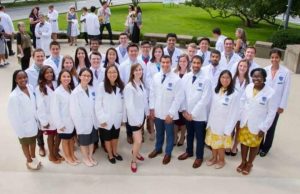Case Western Reserve University Medical School Ranking

What is Case Western Reserve University Medical School Ranking? According to the renowned annual ranking by the U.S. News & World Report, Case Western Reserve University School of Medicine has been rated the top research-oriented medical school in Ohio. Furthermore, the school was regarded as one of America’s top medical schools, at number 24. Case Western Reserve University is placed No. 25 in the Best Medical Schools: Research category, and No. 74 (tie) in the Best Medical Schools category. Primary Care is a term that refers to the
The medical school has two programs: a university program with around 180 students entering each year and the Cleveland Clinic Lerner College of Medicine program with 32 students entering each year. Lerner College offers full tuition for the entire five-year curriculum, which includes a dedicated research year. Nearly 2,000 students applied for the three-dozen spots available last year.
Related Post:University of Utah Medical School Ranking
Overview of the Case Western Reserve University
Case Western Reserve University has a faculty-to-student ratio of 3.2:1. There are 2,964 full-time faculty members in the School of Medicine.
Students can earn an M.D. in one of three ways at Case Western Reserve University School of Medicine. The University Program is a four-year program; the College Program is a five-year program that combines research with greater clinical practice; and the Medical Scientist Training Program is a seven-year program that gives both a medical degree and a Ph.D. The Case Western Reserve University medical school curriculum stresses a combination of medical knowledge and public health awareness, as well as the social and behavioral circumstances of illnesses discussed in class. From a typical M.D. to hybrid Ph.degree D./master’s programs, the school provides roughly 25 graduate degree options in total.
Students can volunteer and get experience at The Free Medical Clinic of Greater Cleveland, or they can join one of more than 35 student organizations. Case Western Reserve University School of Medicine, Ohio’s largest biomedical research institution, has been in the vanguard of medical research discoveries, including the world’s first artificial human chromosome in 1997.
The Benefits of Attending CWRU
Clinical Education
Our students are ahead of the game since their hands-on clinical training begins within the first month. They provide specialized training in all aspects of anesthesia, including clinical regional anesthesia, with mandated and optional rotations at over 80 prestigious affiliate hospitals across the country.
Location
The Master of Science in Anesthesia Program at Case Western Reserve University is the only program with a national reach, including locations in Cleveland, Houston, and Washington. Whether you’re from the East Coast, the Midwest, or the Sunshine Belt, CWRU has a location for you.
Reputation
Not only is Case Western Reserve University’s Master of Science in Anesthesia Program one of the country’s oldest, but it’s also housed in one of the top 25 schools of medicine in the country, according to U.S. News & World Report.
Placement of Employment
At the time of graduation, nearly all of their students receive job offers, with many receiving offers in the fall of their second year. Their May graduation permits their students to enter the job market ahead of other MSA graduates, which means our students have a wider range of job opportunities—and may start earning sooner!
Community
The CWRU MSA community is noted for its closeness. In Cleveland, Houston, and Washington, students can rely on our teaching and staff. We’re there for you when you reach milestones, when you need a little extra help, and every day in between.
Related Post:List of Best MBA Programs in California
What is Case Western Reserve University’s acceptance rate?
The acceptance rate at Case Western is 30%. Case Western’s acceptance rate this year reflects the school’s increasing selectivity. In 2019, the school had its most selective admissions year. The middle 50% of admitted students have SAT scores of 1350-1490 or ACT scores of 31-34, according to Case Western’s admissions records. Furthermore, 95% of admitted students were among the top 25% of their high school class.
Even more so, the Case Western Pre-Professionals Scholar Program. Last cycle, the Case Western PPSP acceptance rate was only 1%, which is thirty times lower than the overall Case Western acceptance rate.
The Case Western PPSP acceptance rate is substantially lower than the Case Western acceptance rate because there are only 25-30 open slots in the program.
You shouldn’t be concerned about Case Western’s admission rate. Don’t be concerned if the Case Western extra essays and the Case Western PPSP acceptance rate appear difficult. Keep in mind the advantages of being accepted into the Case Western PPSP. Both the Medical and Dental Case Western PPSPs ensure admission to Case Western’s professional schools if all prerequisites are met. They also give you a framework to follow as you pursue your career goals.
You should not be bothered by the low Case Western acceptance rate. While the Case Western PPSP acceptance percentage is low, keep in mind that your admissions decision is based on a number of variables. You can overcome the Case Western PPSP acceptance rate if you create great Case Western supplemental essays.
Is Case Western University concerned about essays?
Yes, your Case Western extra essays are important to the admissions committee. Given the incredibly low acceptance rate for the Case Western PPSP, you’ll want to take advantage of every opportunity to demonstrate to the admissions committee who you are and why you are an exceptional candidate. Because extra essays are exclusively required for PPSP applicants at Case Western Reserve University, they are critical to making your Case Western PPSP application stand out in admissions.
If Case Western is one of your top choices, you should devote some time to completing your supplemental essays. Thus, despite the low Case Western PPSP acceptance rate, submitting the greatest Case Western PPSP essays possible can help you increase your chances of getting into Case Western PPSP. Even if PPSP does not grant you a slot, you may be considered for admission to Case Western’s undergraduate program.
Comprehensive List of Best Medical Schools in the United States
Harvard Medical School
We don’t need to trumpet Harvard’s praises; as America’s and the world’s top medical school, HMS has earned its reputation.
The production of artificial skin for burn victims, the first successful reattachment of a severed limb, and the introduction of insulin to treat diabetes are just a few of the school’s many medical accomplishments.
MD students have the option of following one of two paths. Pathways, for example, is a standard four-year program that emphasizes active learning and early clinical rotations. Students in the Pathways program take classes with Harvard dental students. The Health Sciences & Technology (HST) program, which is provided in collaboration with MIT, is the other option. HST students learn a comprehensive curriculum in both physicianship and biomedical engineering alongside MIT PhD students.
HMS students receive instruction from a range of Boston-area teaching organizations, including the Dana-Farber Cancer Institute, Beth Israel Deaconess Medical Center, Joslin Diabetes Center, and Massachusetts Eye and Ear Infirmary.
The Grossman School of Medicine at New York University is likely most known for removing tuition for all current and prospective medical students, a life-changing opportunity that began in 2018.
NYU also offers a variety of dual degree programs, including those that combine an MD with a master’s degree in health policy and management, global health, general management, bioethics, and clinical investigation. There is also a three-year accelerated MD program built after McMaster University Medical School in Canada.
Scientific accomplishments have a lengthy history at the Grossman School. The ubiquitin mechanism in protein breakdown was discovered by Avram Hershko, who received the Nobel Prize in Chemistry in 2004. Julius Axelrod received the Nobel Prize in Medicine in 1970 for his work on catecholamine neurotransmitters such as adrenaline, norepinephrine, and dopamine production and reuptake.
The Grossman School is part of NYU Langone Health, which includes the Clinical and Translational Science Institute, the Institute for Computational Medicine, and the Skirball Institute of Biomolecular Medicine, among others.
Related Post:Korea University Acceptance Rate
Duke University Medical School
Duke’s medical curriculum is divided into four sections: basic sciences (first year), clinical rotations (second year), scholarly research (third year), and clinical electives (fourth year) (fourth year). As a result, students gain early clinical experience while still having the opportunity to explore their research interests.
The Duke Clinical Research Institute is the largest university clinical research organization in the world, conducting phase I to phase IV trials across a wide range of disorders. The large number of patient registries — over 100,000 — is extremely beneficial to researchers.
Duke also founded the country’s first physician assistantship program, which began in 1965. It continues to produce the best PAs in the country today.
Samuel Katz, the inventor of the measles vaccine, and gastroenterologist Peter B. Cotton, the inventor of the ERCP treatment, are among the notable faculty members.
Stanford University School of Medicine
Stanford was founded sometime in 1858 and is California’s first medical school.
The School of Medicine has an impressive graduate study program in biosciences, with a concentration on cell biology, genetics, genomics, and bioinformatics, in addition to neurology and neurobiology.
Stanford’s curriculum, like those of UCSF, University of Washington, Duke, and University of Michigan, uses an innovative “flipped classroom” model in which students hear lectures outside of class then participate with classmates on “homework” tasks in class. A better level of interest and knowledge of essential content benefits students.
A distinguished Master of Science in PA Studies is also offered by the School of Medicine, which teaches and educates future physician assistants alongside MD students.
Physician and paralympian Cheri Blauwet, former director of the world’s first sleep medicine clinic Alexander A. Clerk, and heart transplant pioneer Randall B. Griepp are among the distinguished graduates.
School of Medicine, University of California, San Francisco
UCSF is the nation’s top medical school for internal medicine and obstetrics and gynecology.
It also has a special focus on treating San Francisco’s underprivileged populations. To address healthcare inequities, the Benioff Homelessness & Housing Initiative, the Center for Community Engagement, and Population Health & Health Equity all work together. They want UCSF to be as accessible to the public as a public library.
Stanley Prusiner, along with bacteria, viruses, fungi, and parasites, discovered prions, a new disease-causing agent, at UCSF. He was awarded the Nobel Prize in Medicine in 1997 for this work.
The biological origins of retroviral oncogenes were found by Nobel Laureates Michael Bishop and Harold Varmus in 1989.
Faculty and alumni from UCSF’s medical school have also received Lasker Awards, Shaw Prizes, and National Medals of Science.
Columbia University is a private university in New York City College of Physicians and Surgeons of Vagelos
Columbia, like UPenn, has a long tradition of training physicians that dates back to before the American Revolution.
Vagelos College was the country’s first medical school to replace all student loans with need-based scholarships in 2018. This means that 20% of students will be able to attend for free.
Columbia has redesigned the curriculum into three main sections: Fundamentals, Major Clinical Year, and Differentiation and Integration, rather than the traditional differences between years one through four. In order to receive their degree, students must also complete a scholarly research project.
The Celiac Disease Center at Columbia, led by Dr. Peter Green, was named the world’s leader in Celiac disease expertise in 2018.
Nobel Laureates Richard Axel, Eric Kandel, and Joachim Frank, as well as novelist and neurologist Oliver Sacks and Pulitzer Prize winner Siddhartha Mukherjee, have all served on the faculty.
FAQs
Is there a preferred major
There is no such thing as a “better” major. A major that includes more demanding science coursework, for example, may help a student feel more prepared for the medical school program. Furthermore, keep in mind that most undergraduate schools offer career counselors who can and should help you choose courses and plan for your future.
What criteria are utilized to assess candidates?
Without the context of a comprehensive application, academic credentials cannot be evaluated. Each candidate’s academic success (GPA, coursework, MCAT), letters of recommendation, important life experiences, leadership, clinical experiences, research, and shown commitment to medicine are all considered by the admissions committee. All of this information is taken into account when deciding whether or not to interview and/or accept.
What is the best time for me to take the MCAT?
When you’re feeling the most ready. Because every student learns differently, you are encouraged to study for the MCAT in the manner that best suits you. Some students choose to study independently, while others enroll in preparation classes. Only the method that works best for you is recommended.
What is the admissions procedure?
Please take the time to read over the university’s application procedures on their website. Take great note of the deadline, as failing to adhere to it could endanger your application. Any changes to your status or contact information (address, email, phone number, etc.) should be reported to both their office and AMCAS. This institution accepts students on a rolling basis.
What is the Grading System, and how does it work?
MSTP and University Program: In the first eighteen months of didactic training, you will receive a pass/fail grade. There is no such thing as a class ranking. Students are given additional formative assessments throughout their third and fourth year clinical rotations, such as Honors, Commendable, Satisfactory, and Unsatisfactory.
Lerner College of Medicine at Cleveland Clinic (CCLCM): There are no grades, rather students are assessed based on their competency attainment.









